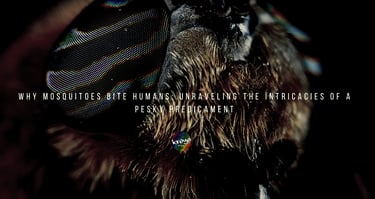Why Mosquitoes Bite Humans: Unraveling the Intricacies of a Pesky Predicament
NATURE


The incessant whine of a mosquito near your ear often marks the beginning of a familiar summertime annoyance: mosquito bites. These tiny insects, while seemingly harmless, have an uncanny ability to elicit itchy welts and rashes, leading to the inevitable question: Why do mosquitoes bite humans in the first place? In this exploration, we delve into the intricate world of mosquitoes, examining the factors that drive their biting behavior, the fascinating biology behind their bites, and the evolutionary history that ties humans and mosquitoes together.
Section 1: The Need to Feed - Why Mosquitoes Bite
1.1 Nourishment for Reproduction
Mosquitoes are driven to bite humans primarily for one reason: sustenance. Female mosquitoes, in particular, require a blood meal to support their reproductive cycle. Blood provides the essential proteins necessary for the development of mosquito eggs. While male mosquitoes feed solely on nectar and plant juices, females need the added nutrients from blood to successfully lay their eggs and ensure the survival of their offspring.
1.2 Seeking the Right Ingredients
Blood is a rich source of essential nutrients, including proteins and iron, which are vital for mosquito reproduction. The proteins from blood aid in egg development and subsequent hatching, while the iron supports the mosquito's physiological processes. In essence, when mosquitoes bite humans, they are not only feeding themselves but also gathering the necessary ingredients for future generations.
Section 2: The Biology of a Mosquito Bite
2.1 Attracted by Scent and Heat
Mosquitoes have an impressive array of sensory tools that guide them to their human hosts. They are attracted by a combination of factors, including body heat, carbon dioxide exhaled during respiration, and the distinct scent of sweat and skin. Once a mosquito detects these cues, it hones in on its target with remarkable precision.
2.2 Insertion of the Proboscis
Upon locating a suitable host, the mosquito employs its proboscis—a long, slender mouthpart—to pierce the skin. The proboscis consists of multiple components, including sharp stylets that puncture the skin and locate blood vessels. These stylets are accompanied by a specialized saliva delivery tube that allows the mosquito to access blood while simultaneously injecting saliva.
2.3 Saliva and Its Role
The injection of mosquito saliva is a crucial aspect of the biting process. Mosquito saliva contains an array of bioactive compounds that serve several functions. First, it acts as an anticoagulant, preventing the host's blood from clotting and allowing the mosquito to feed more efficiently. Second, mosquito saliva contains immunosuppressive agents that dampen the host's immune response, reducing the likelihood of a prompt reaction.
Section 3: The Evolutionary Dance
3.1 A Coevolutionary Tale
The interaction between mosquitoes and humans is a product of coevolution—a reciprocal evolutionary process where the traits of one species influence the traits of another. Over millennia, mosquitoes have adapted to exploit the abundant food source provided by humans. Conversely, humans have developed various strategies to protect themselves from the nuisances and diseases associated with mosquito bites.
3.2 The Malaria Connection
The relationship between mosquitoes and humans also extends to disease transmission. Mosquitoes are vectors for several deadly diseases, including malaria. The Plasmodium parasite, responsible for malaria, completes part of its lifecycle within the mosquito's body. When an infected mosquito bites a human, it transfers the parasite, initiating the infection. This intricate dance between mosquitoes and the pathogens they carry has had profound impacts on human health and evolutionary dynamics.
Section 4: Variability in Biting Behavior
4.1 Species-Specific Tendencies
Not all mosquito species exhibit the same biting behaviors. Some species are highly attracted to human hosts, while others prefer animals or birds. This variation is influenced by factors such as genetics, habitat, and diet. For instance, mosquitoes that primarily feed on birds are less likely to transmit diseases to humans, as the pathogens may not thrive in avian hosts.
4.2 Time of Day Matters
Mosquitoes also exhibit time-specific biting tendencies. Some species are active during the daytime, while others are more active at dawn or dusk. These behavioral patterns are often linked to the preferences of the mosquito species' preferred hosts. For example, mosquitoes that feed on mammals, including humans, tend to be more active during the evening when their warm-blooded hosts are more accessible.
Section 5: Mitigation and Protection
5.1 Defense Mechanisms
Given the annoyance and potential health risks associated with mosquito bites, humans have developed various strategies to protect themselves. These strategies include wearing protective clothing, using mosquito repellents, and employing bed nets to prevent nighttime exposure. Moreover, the elimination of standing water—where mosquitoes lay their eggs—can significantly reduce mosquito populations.
5.2 Ongoing Research and Innovations
Scientific research continues to shed light on the intricate mechanisms of mosquito behavior and physiology. Innovations such as genetically modified mosquitoes and new methods of mosquito control hold promise


